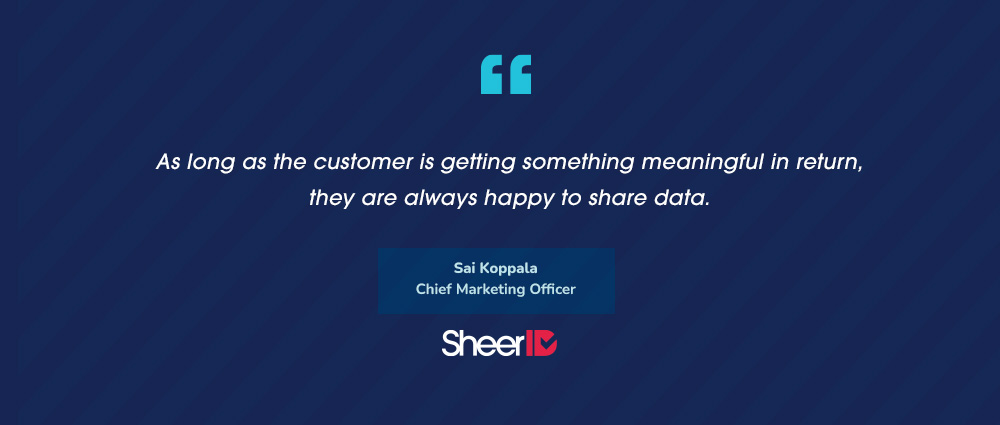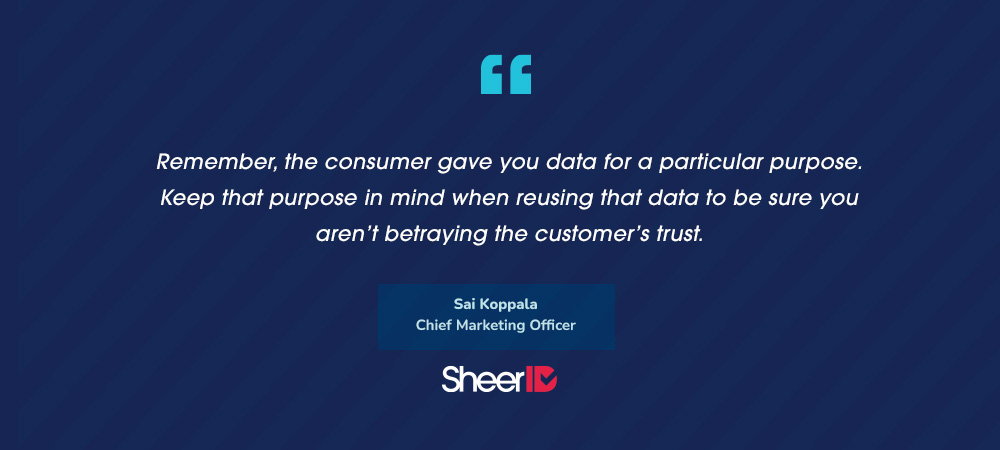How Marketers Can Leverage Forrester’s Study on Zero-Party Data

Marketers understand the importance of quality data—85% say they need it to create personalized experiences that effectively engage customers. But data deprecation is making quality data harder to come by, thanks to the phasing out of third-party cookies and increasingly strict data privacy laws. Marketers are concerned: virtually all (99%) say they are working to address the issue.
A promising solution is zero-party data—data that a customer willingly provides directly to a brand. But for many marketers, zero-party data is a relatively new concept, leaving them unsure how to incorporate it into their strategies.
SheerID partnered with Forrester to conduct a survey of 200 digital marketing decision-makers about the impact of data deprecation and the role of zero-party data. I interviewed Sai Koppala, CMO of SheerID, to provide his perspective on the findings and how marketers can use this information to achieve their goals.
Data Collection is Changing
Tony Coray: To start, why did SheerID conduct the survey?
Sai Koppala: SheerID has worked with hundreds of the world’s leading B2C brands for the last 10 years, and they’re all going through a seismic change in terms of their customer data strategy. Increasingly, brands are realizing that they need to move away from third-party data and prioritize zero-party data. We commissioned this study with Forrester to see if this shift is a broader trend and what it means for marketers moving forward.
Tony Coray: Forrester says that having a zero-party data strategy is important to building resilient and sustainable marketing programs. Why is that?
Sai Koppala: The best way to engage customers in this noisy marketplace is through personalization. Traditionally, brands have relied on third-party data to achieve personalization, but with platforms such as Google and Apple phasing out cookies and stricter privacy regulations in place, access is limited.
Third-party data is becoming inaccurate fast, and to meaningfully engage customers, you need accurate data. And the most accurate data is what the customer directly gives you: that’s zero-party data.
Creating a Zero-Party Data Strategy
Tony Coray: Many marketers are eager to gather zero-party data but don’t know how. What approach should they take?
Sai Koppala: The best way to collect customer data is to offer an incentive for providing it. As long as the customer is getting something meaningful in return, they are always happy to share data.
This value exchange can take various forms depending on a brand’s products and its customers. For example, makeup brand NARS has a lip shade finder quiz that asks questions to determine the best lip color for customers.
Other brands will offer a customer product. Proven Skincare provides a survey asking about customers’ skincare concerns, and in return, it recommends a personalized skincare system.
Exclusive offers are another effective strategy. Consider nutrition brand Gainful, which ran a successful student discount program that lifted retention by 18% in the first month alone.

Guaranteeing Your Data is Reliable
Tony Coray: Marketers reported that their biggest challenge with zero-party data is ensuring its accuracy. How can they meet that challenge?
Sai Koppala: It’s not just about getting data; you also need to validate it. Brands can partner with companies like SheerID that digitally verify a customer’s identity to ensure the data is accurate.
But not all verification providers are equal. When choosing a verification partner, be sure to ask these questions:
- Does the verification partner use authoritative data sources?
- Does the verification process only ask for minimal, privacy-friendly information?
- Will you own the data?
- Does verification occur in-brand or will your customers have to leave your website to create a separate account with a third-party?
- Is robust fraud protection included?
It’s also important to work with a verification partner that can verify all the the consumer communities you want to reach. You want a platform that can not only verify communities you are currently targeting but also other groups and regions your brand might want to expand into.
Ways to Use and Collect Zero-Party Data
Tony Coray: How can customers best use zero-party data to meet customer acquisition and other goals?
Sai Koppala: During acquisition, you need something compelling to get customers interested. An effective way of doing this is to extend a special offer to a specific consumer community, like college students, healthcare workers, or the military. Exclusive offers make customers feel rewarded for who they are; for instance, more than 60% of teachers, healthcare workers, and military members feel valued when a brand extends an offer just for them.
From there, the data you gather needs to be integrated into platforms such as your CDP or CRM so you can re-engage customers on an ongoing basis. Brands such as Rothy’s and Madewell re-engage teachers during special events like Teacher Appreciation Week.
For even greater personalization, you can integrate your data into your loyalty program. For example, ASICS added their data into OneASICS, and as a result, the program has seen double-digit growth, driving acquisitions and boosting conversions.
Remember, the consumer gave you data for a particular purpose. Keep that purpose in mind when reusing that data to be sure you aren’t betraying the customer’s trust. By building trust and continuing to extend value long after acquisition, you drive further engagement and foster loyalty.

Tony Coray: More than half of marketers said they’re investing in third-party technology to capture zero-party data. What advice would you have for them?
Sai Koppala: The best approach is to determine what your goals are and then choose technology that will help you meet them. Wyng and Jebbit are good options if you want to collect taste preferences directly from customers. If you’re looking to leverage your current customer base or acquire new customers, I would recommend Yotpo or Extol. And to create personalized offers based on lifestage, career, or affiliations, SheerID can help.
Make the Most of Zero-Party Data
Both our interview with Sai and the Forrester study point to a key takeaway: marketers need to learn how to incorporate zero-party data into their strategies. Doing so will allow brands to not only overcome the challenges of data deprecation but also build customer loyalty and drive engagement through personalization.
You can learn more about how marketers are taking advantage of zero-party data by reading the Forrester study, The Data Deprecation Challenge and the Promise of Zero-Party Data.